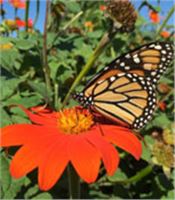Researchers Call On Backyard Scientists To Help Save Pollinators

A monarch butterfly rests on a tithonia flower. Monarchs are one of the species being monitored in the community scientist I-Pollinate project.
Photo by Kelly Allsup.
EMILY STEELE
URBANA, ILLINOIS
Fluttering quietly and steadily from flower to bloom, butterflies, bees and other pollinators do the hard background work of fertilizing flowering plants, fruits and crops. But these unsung heroes are in danger. Studies have shown an estimated 40 percent of insect species, including the monarch butterfly, are at risk of extinction in the coming decades, driven primarily by habitat loss.
“The entomological community is gripped by this impending crisis, but the public doesn’t even know about it,” says May Berenbaum, an entomologist with University of Illinois.
Now, there’s a way for backyard gardeners in rural and urban areas to help. For the fourth year, University of Illinois Extension is calling all lovers of bees, butterflies, and every pollinator in between to join scientists for the community research project I-Pollinate.
Using at-home flower gardens either in the ground or in containers, I- Pollinate volunteers of all ages can observe pollinators and submit data to help track their distribution and habitats.
Volunteers will spend time outside, often with friends and young family members, learning about scientific research, plants, and pollinators. Illinois Extension Horticulture Educator Kelly Allsup works with project volunteers.
“We learn how to identify what’s in our gardens, but also about the scientific process,” says Allsup. “Even no data is data that the scientists need to make recommendations on what plants can support pollinators.”
Researchers have three projects the public can join. One focuses on planting a study garden to see which ornamental landscaping flowers pollinators are food sources. Another tracks monarch butterfly eggs and caterpillars.
The I-Pollinate BeeSpotter project records bumblebee and honeybee sightings to help create accurate distribution maps for Illinois.
Reports from rural areas are extremely helpeful. He says they hope more people in rural areas join.
Those interested in helping scientists conserve pollinators can learn more about the project at ipollinate.illinois.edu. Volunteers will be trained on how to collect data, with the first collection starting in June. ∆
EMILY STEELE: Illinois Extension, media communications coordinator, University of Illinois